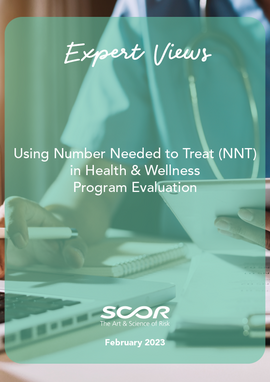- FR
- EN
Using Number Needed to Treat to Evaluate Health & Wellness Programs
Health and wellness programs can help policyholders live longer and healthier lives. The Number Needed to Treat is one tool for evaluating the effectiveness of these programs.

Life insurance companies are eager to assist their policyholders in meaningful ways. Policies provide financial protection in the case of early death, many of which are preventable.
Preventable deaths all have one thing in common: the presence of one or more modifiable risk factors. Recognizing these modifiable risk factors is the first step followed by taking specific actions to mitigate them.
Some companies have recognized this and are considering health and wellness programs designed to assist their policyholders in recognizing modifiable risk factors and doing the necessary interventions to eliminate or mitigate them. Participating in a health and wellness program can lead to the policyholder enjoying a longer and healthier life in addition to forming a stronger bond with the life insurance company.
Many third-party companies are dedicated to providing health and wellness programs with numerous targeted conditions and with varied approaches. With limited available resources it is important for life insurance companies to identify programs that are most meaningful and have the best opportunity to be successful. When comparing various programs, one frequently used tool is the number needed to treat (NNT) calculation.
What is the NNT?
The NNT is a measure of a treatment effect. It is sometimes easy to think that actions recommended by health professionals will be successful for every individual. Unfortunately, that is not always the case. For example, screening mammograms are recommended for discovery of abnormalities associated with early-stage cancer. Often, those early-stage cancers are more successfully treated when compared to late-stage breast cancer, and thus breast cancer deaths can be avoided.
Studies have clearly shown benefit of screening mammograms, so it is easy to think that if one obtains a mammogram as per the guidelines and recommendations, they will not die from breast cancer. That is not true. Even if a person is compliant with the guidelines and obtains mammograms as recommended, he or she can still die from breast cancer.
A mammogram is a tool that is considered very helpful, but it can’t prevent all cancer deaths. In addition, many women will never develop breast cancer; therefore, they won’t benefit from that screening. It isn’t possible to identify those people individually so the recommendation is for all women to undergo mammography knowing that some will not benefit directly. Therefore, many women need to obtain the recommended mammograms for one death to be avoided. But how many?
The NNT tool helps answer that question. This paper considers the value of the NNT in context with a large population of people not for one individual. Everyone has his or her own risks and considerations, and the NNT designed for population management is not as impactful for an individual assessment. For instance, high-risk individuals, based upon family history or other risk factors, have different screening recommendations, and the benefit of screening of a high-risk individual will be much higher than that for a person of average risk.
Each health-related activity designed to eliminate a modifiable risk factor has a different NNT. As H&W programs are being developed, the NNT tool is one factor that can be used to help select the components of the program. Learn more about NNT and its use cases in the Expert Views article linked at right.
Please take a minute to share your feedback via this brief survey.
